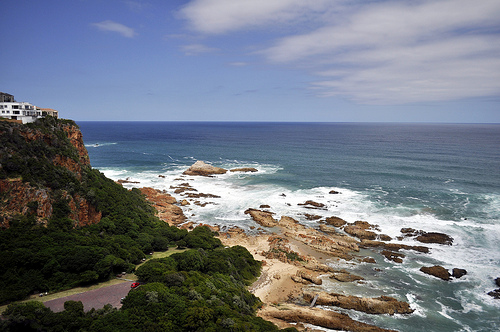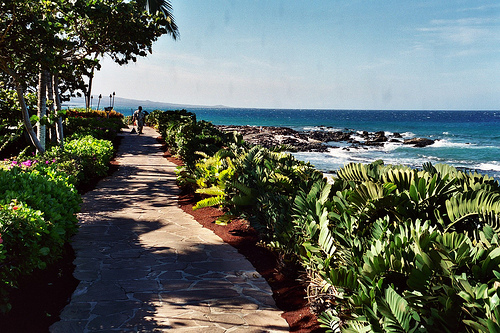Plants for Beachfront and Seaside Gardens in Southern California

Question from Zachary:
What plants will grow in gardens close to the coast and right on the beach front in Southern California?

Photo by Alan Light 
Answer from Pat:
Trees that will survive on the oceanfront in Southern California include the following: Monterey cypress (Cupressus macrocarpa), Leyland cypress (x Cupressocyparis leylandii), flooded gum tree (Eucalyptus rudis), bushy yate (E. conferruminata usually sold as E. lehmannii), compact sugar gum (E. cladocalilyx ‘Nana’), flame eucalyptus (E. ficifolia), rustyleaf fig (Ficus rubiginosa), cajeput tree (Melaleuca quinquenervia), New Zealand Christmas tree (Metrosideros excelsa), M collina ‘Spring Fire’ or ‘Figi’; palm trees including Brahea edulis, Butia capitata, Chamerops, cocos, Phoenix canariensis, P. dactylifer, P.reclinata, Sabal blackburniana, S. palmetto, Washingtonia robusta; Aleppo pine (Pinus halepensis), shore pine (P. contorta), Bosnian pine (P. heldreichii), Bishop pine (P. muricata),) Italian stone pine (P. pinea), holly oak (Quercus ilex), and California laurel (Umbellaria californica).
Shrubs that will survive on the oceanfront in Southern California include:strawberry tree (Arbutus unedo), natal plum (Carissa macrocarpa), rockrose (Cistus), wire netting plant (Corokia cotoneaster), Australian fuchsia (Correa), hop bush (Dodonaea viscosa), lemon leaf (Eleagnus), pink flowered shrub (Escallonia), evergreen euonumus (Euonymus japonicus), Grisiliana, needle bush (Hakea), Hebe, Juniperus (several), Kalanchoe, Lantana, lavender (Lavandula), tea tree (Leptospermum), Melaleuca, oleander (Nerium oleander), Jerusalem sage (Phlomis), Pittosporum crassifolium, P. tobira, Protea compacta, Italian buckthorn (Rhamnus alaternus), Rhaphiolepis, lemonade berry (Rhus integrifolia), Ramana rose (Rosa rugosa), rosemary (Rosmarinus officianalis), evergreen viburnum (Viburnum), coast rosemary (Westringea fruticosa)
Perennials that will survive on the oceanfront in Southern California include: yarrow (Achillea), agapanthus, Tree aloe (Aloe arborescens) and others, sea pink (Armeria maritima), Artemisia, Carex, Jupiters beard (Centranthus ruber), Cape rush (Chondropetalum elephantinum), marguerite (Chrysanthemum frutescens), ground morning glory (Convolvulus sabatius), Dianthus, Pride of Madeira (Echium candicans), seaside daisy (Erigeron), buckwheat (Eriogonum), Euphorbia (several types), Euryops, blue marguerite (Felicia amelloides), Gazania, Iceplants (many kinds), sea lavender (Limonium pereziii), Pink muhlie grass (Muhlenbergia capillaris), Mexican feather grass (Nassella tenuissima), garden geraniums of all kinds (Pelargonium), New Zealand flax (Phormium), lavender cotton (Santolina), Succulents of many varieties—(virtually all of them. I have seen whole gardens of succulents on the cliffs overlooking the sea), and Yucca. Among flowering bulbs try Naked ladies (Amaryllus belladonna). Years ago great drifts of these bulbs made a huge show with aloes, thriving and blooming their heads off on bare cliffs overlooking the sea.
For annuals try nasturtiums planted in fall and coastal wildflowers also planted in fall. Water them to get them started. In dry areas with no summer water, try the California native plants sea dahlia (Coreopsis maritima) and giant sea dahlia (Coreopsis gigantea). Neither of these can take any summer water unless provided by Mother Nature herself.
Good choices for potted plants that will survive on the oceanfront in Southern California include many kinds of geraniums and succulents. Use rocks, pebbles, stepping stones, shells, bottles, driftwood, bleached rope, and flotsam and jetsam to create interest in your seaside garden. You can even fill an old rowboat with garden soil and use it as a raised bed. All of the plants mentioned here are good anywhere close to the coast. In back of the house in a sunny spot out of the wind and in a raised bed or a rowboat you could even grow vegetables and herbs. Surround the rowboat with scented geraniums for a great look.
Photo by Darren J Glanville 


Thank you for your information. What about palm trees?? I live on the beach and everything I plant dies from wind salt etc.
If you are having trouble with palm trees why struggle? I gave you a list of palm tree species that will grow at the beach. (Please look again.) I listed all the species. You need to look them up individually and read and learn their characteristics. Purchase a copy of Sunset Western Garden Book. Look under palms and then look up each species it names for seaside use. The palmetto I mentioned is especially sea-front worthy since it can take wind and salty soils. But there are many other plants like Australian tea tree (Leptospermum laevigatum) that thrive right in the ocean wind. You perhaps need to amend the soil so it retains water, water more, and plant tougher choices. I have given you scads to choose from. If all fails, follow the instructions at the bottom of my comments. If you hate doing this yourself hire a knowledgeable garden designer and have them design and plant a proper seaside garden for you like I’ve described with a lot of succulents. You don’t need stuff to stick up in the air like palm trees.
Thanks for the suggestions! My So. Cal. ocean front yard is pure beach sand. I am about to start from scratch and have an opportunity to remove some sand to make room for soil or amendment. What would you recommend? How much? How deep? I would like to plant some small trees, shrubs and grasses.
Ideally remove three feet of sand and replace with three feet of clay-based amended top soil. Thereafter, amend the soil with organics each time you replant. Whatever you do, don’t mix the sand and clay together. Since the sand layer will be on the bottom everything will be fine. Once again, I repeat, never mix the two together. I knew of a home one block back from the beach in Del Mar, California where this was done by a builder forty years ago. Unlike all the other gardens in the neighborhood that garden thrived. The woman who owned the home for twenty years was hugely grateful that she never suffered the problems that other people in her neighborhood underwent with their garden soil and plants drying out and getting tip burn from salt. But it has to be an honest three feet. That is a huge amount, many truckloads of soil. Saying it is one thing. Doing it is another. There was another home with a similar situation but it was solid hard clay, like rock, on a slight slope so water would drain away. In that case the horticulturist (flower grower) who bought the house had the clay bulldozed out and hauled away. He replaced totally with three feet of good garden loam and mounded the soil into interesting contours. That place has a great garden to this day.
Two miles from the ocean and have rock hard clay soil. What are good shrubs/plants for shade most of the day by a wall and not over 5 or 6 ft tall. Want minimum watering.
Would a tangerine tree grow well here if I plant it in full sun?
A handsome, “cast-iron”, drought-resistant Mediterranean plant for shade is bears breech (Acanthus mollis.) It looks great growing against walls and survives fine with moderate irrigation. Prior to planting in your “rock hard clay soil” be sure to apply soluble gypsum according to package directions and dig in plenty of well-aged organic amendment (compost). Acanthus is briefly deciduous in late summer or early fall, but almost immediately springs back to life again from the ground. (You will barely notice this happening.) Apply snail pellets in March. Here are some other choices: A succulent groundcover that prefers shade and can survive with little or no irrigation is Pride of London (Crassula multicava.) Century plant (Agave americana) and foxtail agave (A. attenuata) are large-scale succulent plants that can take these conditions also and either one looks great massed against a wall. Native plants that can survive in shade with no irrigation once established include Ribes malvaceum, Ribes viburnifolium, Quercus dumosa, Epilobium canum subsp. latifolium, Toyon (Heteromeles arbutifolium), Mahonia aquifolium, M. fremontii, Rhus integrifolium, R. ovata, and others. If you need photos of these plants it’s easy to Google them online.
For the first time in 30 years we have something that is chewing off young Juniper branches, but not eating them. We do have ground squirrels, ground rats and rabbits, but never before have we seen this. Any idea who might be doing this? I know rats must chew to keep teeth from overgrowing. Have set traps that they have sprung and no catch. Help before all our almost 30 year old bushes are eaten up. We live on 4 acres in Agua Dulce, high desert.
This is the first time I have heard of this problem. If the cut is made cleanly as if a gardener with a sharp pair of secateurs cut through the stem at a sloping angle, then is is a rat. If there are jagged teeth marks and some threads of bark, it is a rabbit. Some exotic variety of weevil might be a new problem. These come up from the ground and work at night. A layer of earthworm castings on top of the ground under the plant can stop them in their tracks. Mothballs repel rabbits but also attract young children so use with caution. A mulch of balls from Liquidamber trees can keep off rabbits and cats, since they prick their feet. Regarding rat traps, look for the new plastic kind, Victor Power Kill, that work better than the old wooden and metal ones that rats can spring without being caught. Ask at Home Depot or Dixieline or online at Amazon they have 6 in a pack. Often when just one plant is effected and then another, it is just one rat who has developed a penchant for one particular type of plant and comes back every night to get more.